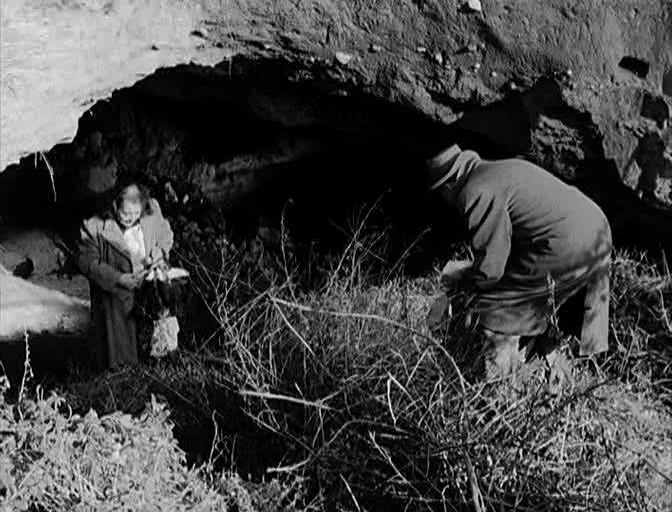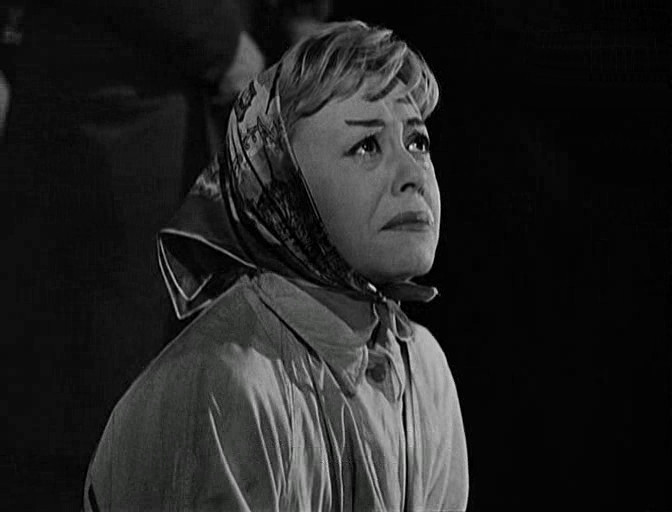Director: Federico Fellini
Writers: Federico Fellini, Ennio Flaiano and Tullio Pinelli
Stars: Giulietta Masina, François Périer, Franca Marzi, Dorian Gray, Aldo Silvani, Mario Passante, Ennio Girolami, Christian Tassou and Amedeo Nazzari
  |
Index: 2020 Centennials.
If 1939 is indeed Hollywood’s Golden Year, as has been so often suggested by critics, then 1957 has a pretty good claim for being the equivalent for world cinema. It’s the year in which Ingmar Bergman released both Wild Strawberries and The Seventh Seal, probably the double whammy of all time, and Akira Kurosawa released both Throne of Blood and The Lower Depths. Mikheil Kaltozishvili’s The Cranes are Flying won the Palme d’Or at Cannes. The UK produced both Jacques Tourneur’s Night of the Demon and the year’s biggest hit, David Lean’s The Bridge on the River Kwai. Even the US contributed movies which could easily be seen as world films rather than typical Hollywood fare: Billy Wilder’s Witness for the Prosecution, Stanley Kubrick’s Paths of Glory and Sidney Lumet’s 12 Angry Men. In such company, the Best Foreign Language Film Oscar went to Italy (and director Federico Fellini) for a second time. Nights of Cabiria followed La Strada, supposedly nudging out Mother India by a single vote. Before Fellini, it wasn’t a category but a special award.
And I’m not going to argue with that. It’s a film not easily forgotten. Janet Maslin wrote in The New York Times that the final shot of Giulietta Masina in Nights of Cabiria is more valuable than “all the fire-breathing blockbusters Hollywood has to offer” and we have two hours of cinematic magic in which we can revel before we get to that point, if we include the seven minute “man with the sack” segment which had been removed after the film premièred at Cannes. Film legend tells us that this was due to censors bowing to pressure from the Roman Catholic Church, but producer Dino de Laurentiis later owned up to stealing that scene from the negative himself because, in his opinion, it slowed down the film. It doesn’t and it offers a valuable contrast to other sections of the picture. To me, it would seem unbalanced without it and, fortunately enough, I’m reviewing it today for Fellini’s centenary because it’s one of only a few of his films that I’ve never got round to watching, so I’ve still never seen it without the “man with the sack”.
 |
Nights of Cabiria started with Fellini’s solo directorial career in 1952, with a feature film called The White Sheik. It wasn’t his first film, as he had been an assistant director on four movies, including Roberto Rossellini’s Rome, Open City and Paisan; he had written or co-written over twenty; and he’d co-written and co-directed Variety Lights with Alberto Lattuada, although it hadn’t been a success. He was able to direct The White Sheik on his own, turning out an enjoyable comedy in which a newly married couple visit Rome with a pair of different agendas in mind, Ivan to introduce his wife to his family and the Pope but Wanda to find the White Sheik, the star of a romantic photo strip with which she’s obsessed. To film history, though, it’s most important for a brief segment in which Ivan, wandering the streets of Rome, runs into a couple of prostitutes, one of them Cabiria, played by Fellini’s wife, Giulietta Masina. It’s a fantastic scene, in which Cabiria’s colleague tries to pick Ivan up while she, full of life, merely tries to cheer him up.
Masina had appeared in Paisan and Variety Lights, but was not seen as star material. However, Fellini himself, talking about her role in The White Sheik, said that, “She was so wonderful, the producer could no longer say she wasn’t capable of playing Gelsomina, and of course Nights of Cabiria was inspired by this scene.” Gelsomina was her character in La Strada, acting opposite Anthony Quinn and Richard Basehart, and she was fantastic, a natural clown whose frequent comparisons to Charlie Chaplin are entirely appropriate. In fact, Chaplin apparently described her as “the actress who moved him most”, though I can’t find the source for that quote. She’s even better here, as the focal point for the entire picture, which was written for her and in which every other character is there in support of her. She won the Best Actress award at Cannes, though it was a fellow Italian who snuck into that category at the Oscars, Anna Magnani for Wild is the Wind, coincidentally starring opposite Anthony Quinn.
 |
Unfortunately, Giorgio isn’t interested in Cabiria as much as he’s interested in the 40,000 lire in her purse, which he promptly steals after pushing her into the river Tiber and running away. Given that she’s unable to swim and the Tiber has a strong current, this is less a mugging and more an attempted murder. She’s only known him for a month and she struggles to understand his actions. She gave him everything he wanted, after all, and realising the irony in this situation is a beginning to how we can understand Cabiria. Another factor is how quickly she changes mood. Angry and unwilling to face the truth, she doesn’t thank the people who save her life by fishing her out of the river and, on getting home, verbally abuses her friend Wanda, a fellow prostitute, something rotten. A few hours later, however, she’s happy again, dancing the mambo in the middle of the street with some random guy, and it’s no act. Everything is emotion for Cabiria and she lives in the moment, a resilience built into her that allows her to continue to function.
 |
She’s utterly magnetic in the Piccadilly, where she’s a fish out of water and most of the fantastic faces occupying their spots in this world end up looking at her. The dance scene here is amazing and I don’t just mean the show with a pair of scantily clad dancers in some exotic tribal performance, I mean the moment when Lazzari remains almost completely still on the dancefloor while Cabiria goes wild around him, ignoring every head she turns. She’s taking ownership of the moment. Off to eat supper at his house, which is massive, far bigger than the nightclub they’ve just left. On the way up to his room, he finally asks her name, which is telling. So is the way in which he throws his jacket onto the floor. She’s worried that it’ll get wrinkled; he insists on leaving it for the maid. It’s a philosophy of life, throwing things away for other people to take care of. Next he throws away his framed photo of Jessie. Cabiria is so far out of her element that she has Lazzari sign a photo to her saying that she was in his house. Who would believe it otherwise?
 |
If Alberto Lazzari’s world is far above her, to which she could never ascend, then this world of people fallen so low that they have to live within the ground itself is one to which she should never descend. The potential is there, of course—she follows this man on his rounds and recognises Elsa as a former prostitute whom she knew as Bomba—but she’s doing OK, she thinks. As she told Lazzari, she proud to have a house of her own, even her own thermometer, but this revelation shocks her and she thinks back to a religious procession that had passed her in the Passeggiata Archeologica, wondering if there’s a possibility to be saved. Unlike her colleagues, she had actually moved towards it even then, as if wanting to join, but, after the caves, she’s keen to go to church during whatever feast day or scheduled pilgrimage is upcoming. She plans to ask the Madonna for mercy but she’s so taken by the occasion that she asks for her to change her life instead. Outside, she realises it hasn’t. “We haven’t changed,” she rages. “Nobody’s changed.”
 |
I won’t spoil where this goes but there’s an inevitability at work here that will allow you to imagine it. I will say that I can’t recall a film where I’ve rooted for a character more. And, by the time we reach the famous ending, with Cabiria walking out of the woods to find that an impromptu procession of revellers, celebrating we know not what, throngs around her, dancing and playing music, the result being that she finds a smile amongst her tears, we’re practically planning a Gofundme to help the woman out. It’s brutal stuff and not for the faint-hearted, but not in the ways you might expect. Fellini crafted a character so deeply that we sincerely care that she’s happy. Masina endowed her with so much verve that she’s almost a creature from a fairy tale, full of wonder and vitality and love. And the script, for all that it paints her impressionistically through vignettes, deepens her so much that she’s as real to us as a character in a movie ever was. At this point, two hours in, her smile of grace and courage is, as Maslin said, worth everything.
 |
It seems to me that Fellini’s rise in importance came at precisely the right time. With masterpieces already behind him, he was able to benefit from colour filmmaking, Jungian psychoanalysis, LSD, parapsychology, the sexual revolution and a growing fondness for art films by a wider audience. The time was right for 8½, named for the number of films Fellini had made at that point in time; Juliet of the Spirits, again with Masina; Fellini’s Satyricon (“Rome. Before Christ. After Fellini”); Roma; Amarcord; and Fellini’s Casanova, with a memorable lead role for Donald Sutherland; among others. He was Oscar nominated twelve times as a writer or director but didn’t win any of those, though he did land a record four wins for Best Picture: La Strada, Nights of Cabiria, 8½ and Amarcord. He won a fifth, lifetime achievement, award in 1993, but died in Rome later that year, a day after his 50th wedding anniversary, and at his funeral, the trumpeter Mauro Maur played Improvviso dell'Angelo, from La Strada. Giulietta Masina followed him only five months later.
Bibliography:
Dino De Laurentiis: 'Fellini wouldn't cut the scene - so I stole it’ (The Guardian, 11 Jun 1999)
Restoring What Time, and Editors, Took Away by Peter M. Nichols (The New York Times, 17 May 1998)



No comments:
Post a Comment